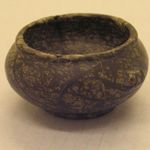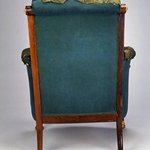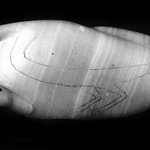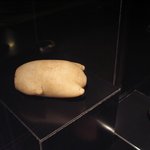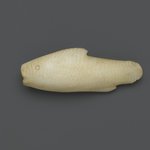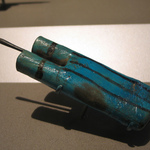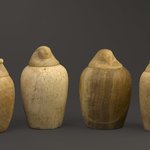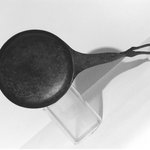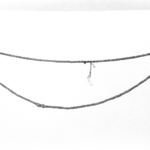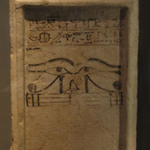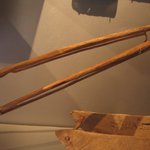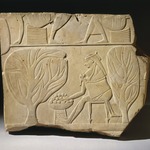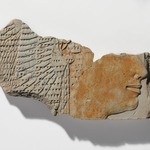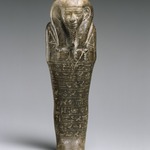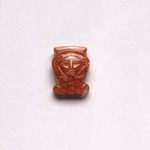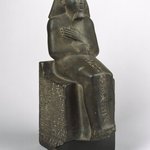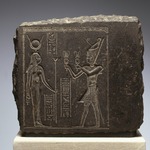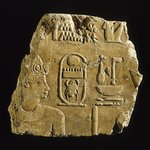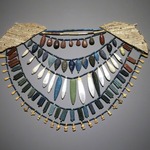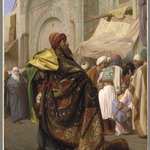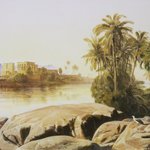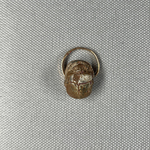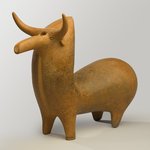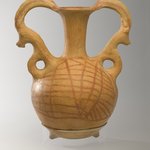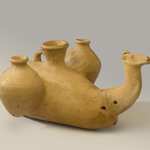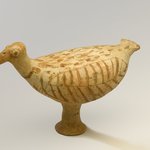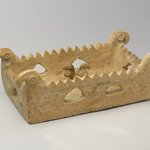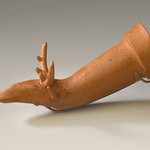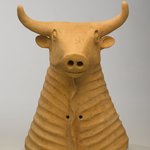
Mounted Scarab of Hatshepsut
Egyptian, Classical, Ancient Near Eastern Art
On View: Egyptian Orientation Gallery, 3rd Floor
Personal Arts
The reigns of Hatshepsut through Thutmose IV represent a transitional phase in Eighteenth Dynasty art.
At first, artists continued to favor simple, elegant forms common earlier in the dynasty, but eventually they developed elaborate, highly detailed designs that dominated the dynasty’s final decades. Under Amunhotep II and Thutmose IV, for example, craftsmen increased the use of a soft, pastel blue pigment that had been invented during the reign of Thutmose III. Potters also molded vessels in human and animal form, and artisans rediscovered the Middle Kingdom fascination for colorful stones such as red carnelian.
Art historians consider the scarabs (beetleshaped amulets) of this era among the finest ever made. Figure Vase of Woman Holding Dog
The reigns of Hatshepsut through Thutmose IV represent a transitional phase in Eighteenth Dynasty art.
At first, artists continued to favor simple, elegant forms common earlier in the dynasty, but eventually they developed elaborate, highly detailed designs that dominated the dynasty’s final decades. Under Amunhotep II and Thutmose IV, for example, craftsmen increased the use of a soft, pastel blue pigment that had been invented during the reign of Thutmose III. Potters also molded vessels in human and animal form, and artisans rediscovered the Middle Kingdom fascination for colorful stones such as red carnelian.
Art historians consider the scarabs (beetleshaped amulets) of this era among the finest ever made. Figure Vase of Woman Holding Dog
MEDIUM
Gold, steatite, glaze
GEOGRAPHICAL LOCATIONS
- Place collected: Egypt
- Possible place made: Thebes, Egypt
DATES
ca. 1478–1458 B.C.E.
DYNASTY
Dynasty 18
PERIOD
New Kingdom
DIMENSIONS
9/16 × 7/8 in. (1.4 × 2.2 cm) (show scale)



COLLECTIONS
Egyptian, Classical, Ancient Near Eastern Art
ACCESSION NUMBER
35.1118
CREDIT LINE
Gift of Theodora Wilbour from the collection of her father, Charles Edwin Wilbour
CATALOGUE DESCRIPTION
Brown steatite scarab, green glazed, inscribed with cartouche of Hatshepsut between feathers. Scarab set in gold mounting originally part of a seal-ring. Pieces longitudinally. Gold mounting slightly dented. Glaze of scarab. Worn. Fine workmanship.
EXHIBITIONS
MUSEUM LOCATION
This item is on view in Egyptian Orientation Gallery, 3rd Floor
CAPTION
Mounted Scarab of Hatshepsut, ca. 1478–1458 B.C.E. Gold, steatite, glaze, 9/16 × 7/8 in. (1.4 × 2.2 cm). Brooklyn Museum, Gift of Theodora Wilbour from the collection of her father, Charles Edwin Wilbour, 35.1118. Creative Commons-BY (Photo: Brooklyn Museum, CUR.35.1118_erg456.jpg)
IMAGE
overall, CUR.35.1118_erg456.jpg. Brooklyn Museum photograph, 10/15/2010
"CUR" at the beginning of an image file name means that the image was created by a curatorial staff member. These study images may be digital point-and-shoot photographs, when we don\'t yet have high-quality studio photography, or they may be scans of older negatives, slides, or photographic prints, providing historical documentation of the object.
RIGHTS STATEMENT
Creative Commons-BY
You may download and use Brooklyn Museum images of this three-dimensional work in accordance with a Creative Commons license. Fair use, as understood under the United States Copyright Act, may also apply.
Please include caption information from this page and credit the Brooklyn Museum. If you need a high resolution file, please fill out our online application form (charges apply).
For further information about copyright, we recommend resources at the United States Library of Congress, Cornell University, Copyright and Cultural Institutions: Guidelines for U.S. Libraries, Archives, and Museums, and Copyright Watch.
For more information about the Museum's rights project, including how rights types are assigned, please see our blog posts on copyright.
If you have any information regarding this work and rights to it, please contact copyright@brooklynmuseum.org.
RECORD COMPLETENESS
Not every record you will find here is complete. More information is available for some works than for others, and some entries have been updated more recently. Records are frequently reviewed and revised, and we welcome any additional information you might have.



